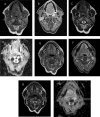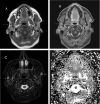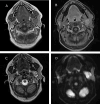Bilateral synchronous salivary gland tumors: report of three cases
- PMID: 40514698
- PMCID: PMC12164054
- DOI: 10.1186/s13000-025-01672-9
Bilateral synchronous salivary gland tumors: report of three cases
Abstract
Background: Bilateral salivary gland tumors, both benign and malignant and synchronous or metachronous are very rare.
Case presentation: Here three cases of synchronous bilateral salivary gland tumors are described and discussed. Recognizing the entity is important for diagnostics and treatment planning. The first patient was a 56-year-old female with a bilateral parotid tumor, a malignant tumor, salivary duct carcinoma on the right side and a benign tumor, pleomorphic adenoma on the left side. The second patient was a 50-year old female with a bilateral benign parotid tumor, a pleomorphic adenoma. The third patient was a 51-year old female with a bilateral malignant tumor, an acinic cell carcinoma. Details on the diagnostic work-up, histopathology and treatment are described and discussed.
Conclusions: In the case of a unilateral salivary gland tumor, especially of the major glands, the contralateral gland is always included in the clinical and radiological (MRI) head and neck evaluation prior to surgery, to detect or exclude possible bilateral occurrence.
Keywords: Acinic cell carcinoma; Pleomorphic adenoma; Salivary duct carcinoma; Salivary gland tumor.
© 2025. The Author(s).
Conflict of interest statement
Declarations. Ethical approval: According to Swedish regulations studies regarding diagnostics and treatment are not considered research and must thus not be ethically permitted. Competing interests: The authors declare no competing interests.
Figures






References
-
- Colangeli W, Facchini V, Kapitonov A, Zappala M, Belli E. Multiple synchronous bilateral neoplasms of Parotid glands. Clin Ter. 2022;173:203–6. - PubMed
-
- Yu GY, Ma DQ, Zhang Y, et al. Multiple primary tumours of the Parotid gland. Int J Oral Maxillofac Surg. 2004;33:531–4. - PubMed
-
- Park KS, Jang HB, Lee DH, Lee JK, Lim SC. Multiple synchronous neoplasms in the ipsilateral Parotid gland: case series. Ann Palliat Med. 2022;11:2641–5. - PubMed
-
- Seifert G, Donath K. Multiple tumours of the salivary glands– Terminology and nomenclature. Oral Oncol Eur J Cancer. 1996;32B:3–7. - PubMed
Publication types
MeSH terms
LinkOut - more resources
Full Text Sources
Medical

